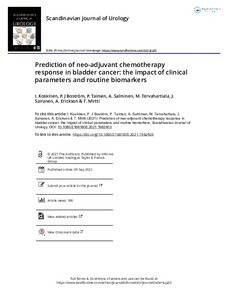Prediction of neo-adjuvant chemotherapy response in bladder cancer: the impact of clinical parameters and routine biomarkers
Koskinen Ilmari; Boström Peter J; Tervahartiala Minna; Salminen Antti; Taimen Pekka; Mirtti Tuomas; Erickson Alek; Sairanen Jukka
https://urn.fi/URN:NBN:fi-fe2021100750361
Tiivistelmä
Purpose
To investigate the role of clinical parameters and immunohistochemical (IHC) biomarkers in their feasibility to predict the effect of neo-adjuvant chemotherapy (NAC) in patients with muscle-invasive urothelial bladder cancer (MIBC).
Materials and methods
The first 76 consecutive patients with MIBC treated with NAC and radical cystectomy in two University hospitals in Finland between 2008 and 2013 were chosen for this study. After excluding patients with non-urothelial cancer, less than two cycles of chemotherapy, no tissue material for IHC analysis or non-muscle-invasive bladder cancer in re-review, 59 patients were included in the final analysis. A tissue microarray block was constructed from the transurethral resection samples and IHC stainings of Ki-67, p53, Her-2 and EGFR were made. The correlations between histological features in transurethral resection samples and immune-histochemical stainings were calculated. The associations of clinicopathological parameters and IHC stainings with NAC response were evaluated. Factors affecting survival were estimated.
Results
The complete response rate after NAC was 44%. A higher number of chemotherapy cycles was associated with better response to neo-adjuvant chemotherapy. No response to neo-adjuvant chemotherapy and female gender was associated with decreased cancer-specific survival. The IHC stainings used failed to show an association with neo-adjuvant chemotherapy response and overall or cancer specific survival.
Conclusions
Patients who do not respond to neo-adjuvant chemotherapy do significantly worse than responders. This study could not find clinical tools to distinguish responders from non-responders. Further studies preferably with larger cohorts addressing this issue are warranted to improve the selection of patients for neo-adjuvant chemotherapy.
Kokoelmat
- Rinnakkaistallenteet [19207]
